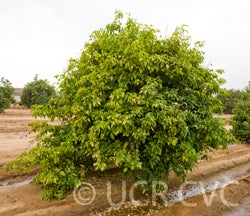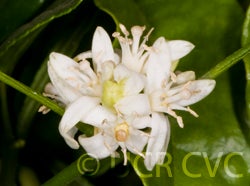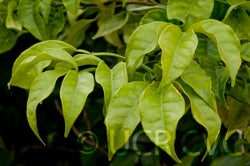Gabon cherry-orange
CRC 3286
PI 246335
Source
Received as seed from Yangambi State of INEAC, Belgium, 1958.
Parentage/origins
Parents unknown.
Rootstocks of accession
Carrizo citrange, C-35 citrange
Season of ripeness at Riverside
Year round
Season of flowering at Riverside
July to December
Notes and observations
11/1958: From a total of 15 seeds: 14 singles & one double.
EMN, 12/22/1987: More a shrub than a tree. Fair now but probably not adapted to Riverside as an ornamental. Foliage is unattractive yellowish-green now. No fruits but blooms and flower buds are present now-- poor tree is confused; probably thinks Santa Claus is coming but will get Jack Frost instead.
Description from The Citrus Industry Vol. 1 (1967)
"A shrub or small tree, 1.5-6 m high, ultimate branches slender, 1.5-3 mm diam., with internodes 2-5 cm long, with single or paired slender spines, 2-2.5 cm long even on fruiting branches; leaves glabrous, 1-5 foliolate, variable in size, 5-foliolate leaves 15.5-19 X 12-15 cm, 3-foliolate leaves 10-13 X 7-10 cm, 1-foliolate leaves 12-17 X 4-7 cm (including the petiole 2-4 cm long), leaflets oblong or elliptical, long-acuminate at the apex or caudate, very variable in size, 1-foliolate leaflets very large, blade 7-14.5 X 3-7 cm, petiole 2-3.5 X 0.4-1.5 cm, with a broadly rounded base, 5-foliolate leaflets usually 8-10 X 4-5 cm, but sometimes smaller, 3.5-8 X 1.5-3.5 cm, terminal leaflet often borne on a short rachis segment and then abruptly narrowed at base, but if borne at apex of first rachis segment with 2 lateral leaflets then narrowly cuneate or acuminate at base and longer than lateral leaflets, petioles variable in size and shape, 1.8-5 X 0.3-2 cm, linear or narrowly elliptical if narrow, obovate if broad, rachis segments often similar in shape to petiole, 3.5-5.5 X 0.4-2 cm; inflorescences short, axillary flower clusters, 1.5-2.5 cm long, peduncles apparently unbranched, 8-9 mm long, pedicels long and very slender, 7-11 X 0.4-0.6 mm (in dry state), short-pubescent, flowers very small, usually 4-merous, buds 5-6 X 2 mm, open flowers about 10-13 mm diam., calyx lobes 4, triangular, acute, with a single medium-sized oil gland near the apex, petals 4, about 6 X 2.5 mm, stamens free, filaments flattened, sparingly pubescent on inner side; disk very small, about 0.5 mm high, pistil very short (4-6 mm, including the disk), ovary obovoid, about 1.5 X 0.8-0.9 mm, 3-4-locular with a large, more or less protuberant oil gland at the top of each locule, style very slender, not expanded at base, about 2 mm long, 0.3-0.4 mm diam., stigma subglobose, 0.9-1 mm diam., slightly 4-lobed, with about 4 large oil glands; fruits subglobose, about 1.8-2.2 cm; borne on pedicels 8-12 X 1-2 mm, nearly filled with 3 or 4 ovoid, smooth, hard seeds, 10-12 X 8-10 X 6-8 mm, with an even-margined hilum 2 X 1 mm, pulp-vesicles almost suppressed the seeds in most fruits.
This species is the type of the subgenus Afrocitrus, which includes also C. zenkeri and C. le-testui. These three species are evidently related to each other and clearly delimited from the six typical species in the subgenus Citropsis.
Citropsis gabunensis has very small flowers, the smallest of any species of the genus. No other species of Citropsis shows as much variation in the number and size of the leaflets. The type material from Sibange Farm, Gabon (and also abundant material collected by Père Klaine near Libreville, Gabon, now in the Paris herbarium), shows whole branches with very large unifoliolate leaves, although more often some of the leaves have two or three leaflets. The typical 5-foliolate form is also common at both places; it often shows a short winged rachis segment bearing the terminal leaflet, something found only in trifoliolate leaves of other species of Citropsis. The large unifoliolate leaves look astonishingly like those of Citrus in every character—size, shape, venation, texture, and color; they even have winged petioles very like those of some forms of Citrus aurantium and C. grandis.
The unifoliolate species of Pleiospermium, P. sumatranum, P. longisepalum, and P. latialatum, also have leaves very like those of Citrus and closely resembling those found on this form of Citropsis gabunensis. Doubtless both Citropsis and Pleiospermium contain species that resemble closely remote ancestral forms from which Citrus has evolved."
Availability
Not commercially available in California.
USDA Germplasm Resources Information Network page for Citropsis gabunensis




